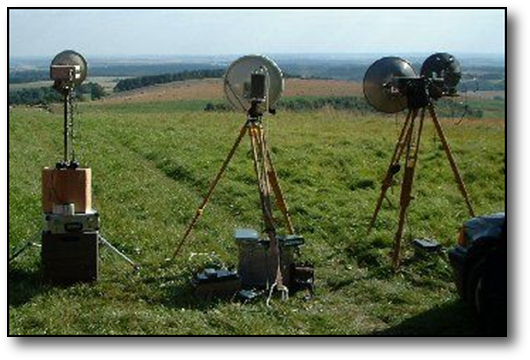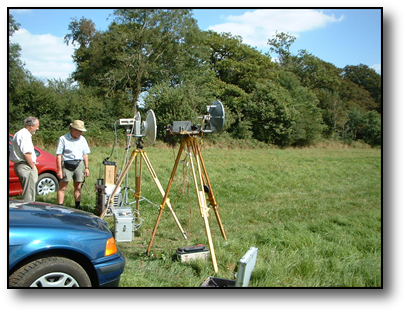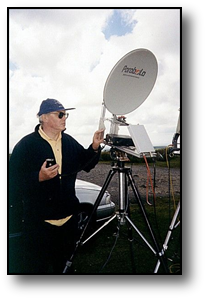
76GHz UK distance records
On the 1st of September 2002 successful two way contacts were made on 75976.2 (i) MHz between G3PYB/P located near Ventnor, Isle of Wight and G8BKE/P and G8ACE/P located near Highclere to the west of the A34 and south west of Newbury, Berks. The distance 79.6km. Contact between G3PYB and G8ACE was on NBFM(ii) and between G3PYB and G8BKE on NBFM (iii) and CW (G8BKE). The success in making this contact, thought to be a new UK distance record for this amateur band was we think due to favourable humidity conditions prevailing on the day. Attempts during 2001 were by and large prevented by the Foot & Mouth restrictions. During earlier 2002 attempts the weather conditions were either unfavourable due to rain or excessive humidity often above 80-90%. The BBC weather information gave humidity values of 58% for Ventnor and Newport IOW, 43% for Southampton and 35% for Andover and Newbury for 1400 GMT. Temperature on the IOW was 22deg C., RH 39%, pressure 1019mB. Visibility approximately 25 to 30km. Thus we had significantly lower values of RH than we had experienced before. The attenuation at these frequencies is significantly affected by water vapour. Earlier experiences show that in choosing a suitable test path a K value of 1 is much more likely to lead to successful exchange of signals rather than K=1.33 Additionally at least 20 metres of clearance has been found necessary between any intervening high ground and the LOS path to avoid penetration of the fresnel zone by trees and buildings when examining possible path profiles. These constraints mean that few long paths from accessible sites in the South of England will meet the concluded criteria for successful communication at the limited transmit power levels we can obtain.
Notes.
i.UK preferred frequency for narrow band operation.75976 - 75978 MHz.
ii.G3PYB and G8ACE use Impatt diode transmitters producing a mW or two of power.
iii. G8BKE uses a beam lead diode multiplier transmitter producing a little less power than the Impatt devices.
iv. Receivers are based on the DB6NT design using anti-parallel beam lead mixer diodes
i.UK preferred frequency for narrow band operation.75976 - 75978 MHz.
ii.G3PYB and G8ACE use Impatt diode transmitters producing a mW or two of power.
iii. G8BKE uses a beam lead diode multiplier transmitter producing a little less power than the Impatt devices.
iv. Receivers are based on the DB6NT design using anti-parallel beam lead mixer diodes


Dishes left to right. G8BKE Rx dish & Tx dish on one tripod and G8ACE Rx dish, Tx dish. with G8BKE listening to G3PYB/P on 75976.2 MHz.
G8BKE and G8ACE listening to G3PYB/P signals

The late G3PYB with his 47GHz equipment used for initial antenna alignment

We had re run an earlier record at 52km to prove the equipment, and we found a gap in the modest hills of Hampshire which gave a fringing path from the old WW1 radar site at Ventor on the Isle of Wight to a hither-to unused site near Highclear castle near the A34.
G3PYB being of old Northern Viking stock (weekend visitor from northern Germany) volunteered to sail with the tourists across the Solent, G8ACE and G8BKE being good land fearing Hampshire sorts took to the trees near Highclere.The path plot shown below looked reasonable and the distance 79km, the centre of the path near Bullington Cross had some high ground but on K=1 we should clear the top with the very narrow beam on 76Ghz.
G3PYB being of old Northern Viking stock (weekend visitor from northern Germany) volunteered to sail with the tourists across the Solent, G8ACE and G8BKE being good land fearing Hampshire sorts took to the trees near Highclere.The path plot shown below looked reasonable and the distance 79km, the centre of the path near Bullington Cross had some high ground but on K=1 we should clear the top with the very narrow beam on 76Ghz.
The dishes have narrow 3db points about 1deg or less pointing was a problem. However we used 47Ghz to set the path, signals were good but not massive, and we could comfortably used FM in 25khz bandwidth. We had enough equipment to keep 47Ghz running and at times 47Ghz was used for talback. Changing to 76Ghz and correcting for small dish beam deviations produced a reasonable CW signal from G3PYBs estimated 8 to 10 mW FM Tx. Separate TX and Rx were in use and Johns G8ACE FM Tx (3db higher output ) was found with ease and almost fully quieting 20db at IF could be added and still have noisy but copyable FM. G8BKE was copying signals at the same time and the contact sequence was completed with a CW exchange the G3PYB on the IOW. Chris G8BKE was using a dual HP signal diode as a multiplier from a 38Ghz TX source. All stations used oven stabilised oscillators on both TX and Rx. Receiver mixers were similar to the DB6NT double HP diode design but with separate 38GHz multipliers from 12Ghz local oscillator chains. Frequency stability was excellent which is a tribute the hard work by G8ACE with his oven stabilised oscillators. The receiver units were in fact transceivers (iv), an attempt to use the unit on CW or SSB proved too much for the 79km path. Signals could be detected by placing the SSB directly on the higher power channels but signals were only just detectable in 3Khz bandwidth. Clearly we're past the limit of a transceiver to transceiver capability with our equipment.
A key element in the success of the 79Km contact was the ability to generate the 10+mW of RF this is many dB higher than the 80 micro Watts we get from the DB6NT mixers. The Russian diodes used by G3PYB and G8ACE are from the Impatt/or Barratt multi junction family (we believe), and are pumped at 7.5Ghz by a few hundred mW of crystal controlled FM modulated sources. Thanks must go to all stations for time and effort to build and align to equipment with only basic test equipment, and the willingness to go out on the hilltops to prove it works.
The record was surpassed on the 9th June 2013 by contacts from Ventnor on the Isle of Wight to Firle beacon, a distance of ~95kms and stood for a while as the new UK record.
A key element in the success of the 79Km contact was the ability to generate the 10+mW of RF this is many dB higher than the 80 micro Watts we get from the DB6NT mixers. The Russian diodes used by G3PYB and G8ACE are from the Impatt/or Barratt multi junction family (we believe), and are pumped at 7.5Ghz by a few hundred mW of crystal controlled FM modulated sources. Thanks must go to all stations for time and effort to build and align to equipment with only basic test equipment, and the willingness to go out on the hilltops to prove it works.
The record was surpassed on the 9th June 2013 by contacts from Ventnor on the Isle of Wight to Firle beacon, a distance of ~95kms and stood for a while as the new UK record.
Later on the 14th September 2013, G8ACE, G8KQW (ably assisted by GW3TKH) and myself tried a line of sight path from Batcombe Down in Dorset to a site just north of Cardiff at Eglwysilan. The path length being 102kms. FM signals were exchanged over this path at good signal strengths between ACE & KQW although the distance proved too great for my bare mixer diode receiver and small lens antennas, (shown left) although my FM source performed well. This did underline the benefit of good LNA's and decent dish antennas. That distance stood as the UK record on 76GHz. ( Video here)
However .............on the 23rd November 2013 G8ACE and G8KQW at Brown Clee Hill (IO82QL) worked G4EAT and G8CUB on Winter Hill (IO83RO) using NBFM. This now stands as the current UK record of 129kms.......but for how long???. (Video recordings here)
However .............on the 23rd November 2013 G8ACE and G8KQW at Brown Clee Hill (IO82QL) worked G4EAT and G8CUB on Winter Hill (IO83RO) using NBFM. This now stands as the current UK record of 129kms.......but for how long???. (Video recordings here)
